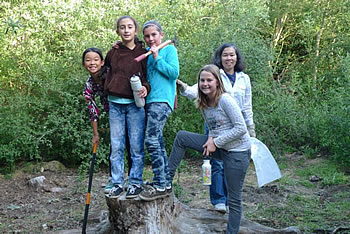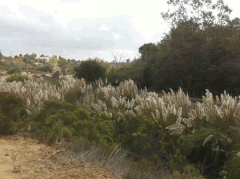San
Diego, California

Photo © Karen Straus
Check your mailbox for our annual snail-mail letter.
The enclosed postcard is of a Scrub-Jay
in Rose Canyon with acorns in its beak.
Rose Canyon is a rare wildlife preserve
in an urban neighborhood.
Thank you for helping us protect and restore it.

Debby Knight, Executive Director
Friends of Rose Canyon
858-597-0220
Rose Canyon
Open Space Park Preserve
Press Conference Sept 2014

It's a big win that the City Councilmembers voted their support for a community plan amendment to remove the bridge from the plan. But a community plan amendment is a mutli-step process. On Monday the City Council kicked off that process with unanimous yes votes to "initiate a community plan amendment." City staff will do studies to assess the current transportation conditions and impact of removal of the bridge. At some future date, the city council will vote on the final community plan amendment.
The Initiative includes the proposal to remove both the Regents Road bridge and the widening of Genesee Ave. from Nobel to the 52 from 4 to 6 lanes (a project that is also in the community plan). Assuming they remove the bridge, we would be very pleased to have them remove the Genesee widening at the same time.
Watch our video:
Kids planting acorns in Rose Canyon
With Kids for Peace and Girl Scout Troop #3222
It's one thing to save Rose Canyon from destruction: we're still doing that. "Keep it Wild" is our motto.
We're also restoring the native trees, shrubs and flowers that grew here before people brought in cows and horses and changed the landscape in other ways. Native Coast Live Oak trees have great spreading limbs that make a beautiful high canopy. We've organized volunteers to clear away non-native plants and bring back oaks and other native plants.

Girl Scout Troop #3222 weeding invasive
thistles (ouch!)
around an old stump.
We work all year round, but only ask for donations this time of year
Make a tax-deductible donation now
Donate with your smart phone or tablet
Celebrate our successes and support our battles to come
Rose Canyon is a last remaining greenbelt, an urban nature preserve. Every proposal to pave some part of Rose Canyon threatens to degrade what remains.
Be a part of saving this greenbelt. It's up to us. It is now or never.
Pampas Grass Eradication
is Underway -
You Can Help
Pampas grass is a non-native plant that spreads easily into San Diego's canyons, especially in wetland areas. It proliferates and crowds out our native plants and trees that provide shelter and food for our native wildlife. Its seeds spread easily via wind, storm water, and our local waterways.
Great News for Rose Canyon
and the whole Rose Creek Watershed Over the next two years, licensed contractors will spray pampas grass in Rose Canyon, Marian Bear Park (San Clemente Canyon), and Rose Creek from the I-5/52 intersection south to Mission Bay. You may see pampas grass that looks blue from the herbicide, which is similar to Roundup and has been approved by state wildlife agencies. It is necessary to use herbicide to eradicate this highly invasive plant.

If this plant is on your property, please eradicate it. Watch out - the leaves are very sharp. Cut off and bag the fluffy seed heads so the seeds don't spread. Spray the green leaves with Roundup (available at garden stores). If you can, dig out the roots. Keep an eye on it, and spray any new green leaves. If you see it on someone else's property, please encourage them to eradicate it.
State grant funds this project Which will help restore native habitat
The Chaparral Lands Conservancy received a grant for this project. The project is part of a larger effort by The Rose Creek Watershed Alliance, including Friends of Rose Canyon, to eradicate non-native plants and restore natives. We are very excited to see this eradication of pampas grass. This will help make possible the restoration of oaks, willows, sycamores, and other native plants in Rose Canyon and the rest of the Rose Creek watershed.

Pampas grass has invaded this area of Rose Canyon and crowded out the native plants and trees that should be growing along Rose Creek in this area of Rose Canyon east of Genesee Avenue.

You may start to notice pampas grass everywhere. Getting rid of it throughout the watershed - on public and private land - is important so that areas don't get re-infested.
We can all be part of the solution.
What to plant instead on your property
View brochure: Don't Plant a Pest
Suggestions for alternatives to pampas grass and other invasive plants and trees.
View 10 native plants for your garden
Attract birds and butterflies. Scroll to see front and back of brochure.
What is a native plant?
Our native plants grew here prior to European contact. They evolved here over a very long period. They co-evolved with animals, fungi and microbes to form a complex network of relationships. They are the foundation of our native ecosystems.
See CA Native Plant Society website.
What is an invasive plant?
An invasive plant is a non-native plant that spreads easily into our open space areas, grows quickly, and crowds out the natives. It also may not have natural enemies (insects or diseases) to keep it in check. Not all non-native plants are invasive. Some non-natives do not tend to spread readily into our open space areas. But especially if you live near a canyon or other natural area, using natives in your yard is best.
Feel free to call or email me any time:
Debby Knight
President
Friends of Rose Canyon
858-597-0220, rosecanyon@san.rr.com
Girl Scouts Help Birds
Win the Bronze in Rose Canyon
Read SAVE THE BIRDS by Robyn Wilkinson, Grade 5
Read article by Debby Knight, President, Friends of Rose Canyon
Fifth grade Girl Scouts in Troop 3012 called us up because they wanted to build bird boxes to help the birds in Rose Canyon. This project led us all on an adventure: the scouts built 12 bird boxes, put them up in Rose Canyon, and monitored them during the spring nesting season to see what birds used them.
They also planted native plants that are good for birds.
Support for this project came from:
SDG&E
Recon Nursery
The California Bluebird Recovery Program

Five of the girl scouts with just-made bird boxes. Back: Richard Griebe, who helped make the project happen; Debby Knight, Friends of Rose Canyon

